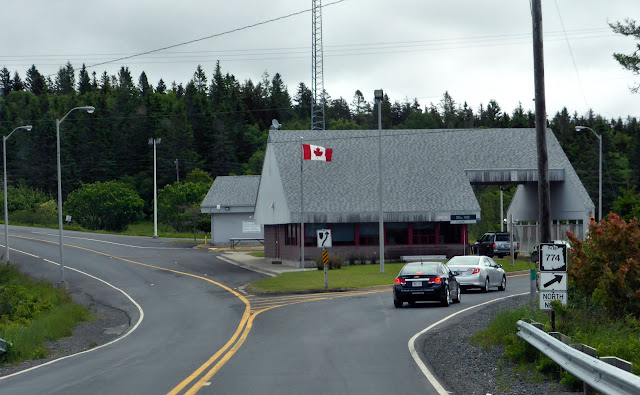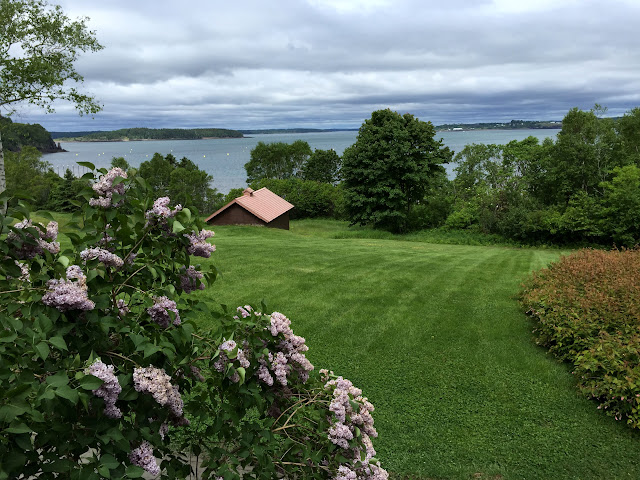MAINE COURSE, Chapter 6.
IN WHICH WE LOSE OUR COOL
space.
Days 7-10. Ellsworth, ME to HomeWednesday, 24 June—Ellsworth to Portland
The sun shone brilliantly over a cloudless blue sky Wednesday morning as we finally left the Ellsworth/Acadia area at 7 a.m., driving west toward Augusta for a visit to the state capitol. Just before 8, we recrossed the spectacular Penobscot Narrows Bridge and shortly stopped at Mt. Prospect Cemetery in Stockton Springs for our first letterbox of the day.
space
 |
| Penobscot Narrows Bridge |
Continuing our letterboxing adventures into Searsport (pop. 2,615), we started at Bowditch Cemetery, the oldest in town. We were on the hunt for a series of 14 letterboxes planted by local boxer Jiffy. Next up was Elmwood Cemetery for two boxes, then an interruption for a trio of boxes not in the series. Then we moved on to Village Cemetery, where we snagged two more but skipped two that were well guarded by poison ivy.
space
Moving on to Mount Hope Cemetery, we located three more. At the time we arrived at the small Gordon Cemetery, the final graveyard, for the last three boxes in the series, preparations were underway for an interment. With a single entrance/exit and no designated space for parking, there was a good chance we would be trapped until the end of the service if we stayed to find the boxes. So we left and drove back to US-1.
space
Moving on to Mount Hope Cemetery, we located three more. At the time we arrived at the small Gordon Cemetery, the final graveyard, for the last three boxes in the series, preparations were underway for an interment. With a single entrance/exit and no designated space for parking, there was a good chance we would be trapped until the end of the service if we stayed to find the boxes. So we left and drove back to US-1.
space
In every Searsport cemetery we visited, we noticed an unusual number of sea captains, as noted by the inscription "Capt." or "Died at Sea." As we later learned, Searsport produced more shipmasters than any town of its size in the world, and was once home to one-tenth of the deepwater ship’s captains in the American Merchant Marine.
space
On our way out of Searsport, we passed a connected farm along the highway that was for sale. Featuring a big house, a little house, a back house and a barn, this type of architecture dominated rural Maine dwellings before 1900, and we had seen quite a few on our travels in the state. With all the buildings linked, a farmer could go from house to shed to barn and complete all his daily chores without setting foot outside, a big advantage on a stormy day or in extreme cold.
space
Driving south on US-1, we tracked near the coast until we reached Belfast (pop. 6,660), a seaport popular with tourists, where we paused to check out the town and have lunch. Our first choice from Yelp wasn't open today, which turned out to our advantage when we ended up at Darby's Restaurant and Pub. Perfectly situated in an 1865 building that originated as a pub, Darby's boasts the same walls, tin ceiling and antique bar that were installed the year the Civil War ended. I ordered their zucchini sliders—seasoned grilled zucchini slices with fresh mozzarella, bean sprouts, tomato and fresh basil mayo. Delicious! Ken had blackened salmon salad with beets and spinach—also excellent.
space
 |
| Another Searsport captain lost to the sea |
space
 |
| Connected Farm |
space
Driving south on US-1, we tracked near the coast until we reached Belfast (pop. 6,660), a seaport popular with tourists, where we paused to check out the town and have lunch. Our first choice from Yelp wasn't open today, which turned out to our advantage when we ended up at Darby's Restaurant and Pub. Perfectly situated in an 1865 building that originated as a pub, Darby's boasts the same walls, tin ceiling and antique bar that were installed the year the Civil War ended. I ordered their zucchini sliders—seasoned grilled zucchini slices with fresh mozzarella, bean sprouts, tomato and fresh basil mayo. Delicious! Ken had blackened salmon salad with beets and spinach—also excellent.
space
From Belfast, we turned inland on ME-3 toward Augusta. The temperature seemed to climb as we moved inland away from the coastal breezes. After visiting the state capitol, we drove on to the Portland area and checked into a Homewood Suites for the next few days, happy to have a little extra elbow room.
space
Thursday, 25 June—Portland
space
When we left the hotel around 9 a.m. Thursday morning, the temperature was already at 72°, a preview of what is to come as we make our way back south. But the sun was shining and the letterboxes waiting, so we set out down US-1 after stopping by the local Michael's to re-supply our ink.
space
space
Thursday, 25 June—Portland
space
When we left the hotel around 9 a.m. Thursday morning, the temperature was already at 72°, a preview of what is to come as we make our way back south. But the sun was shining and the letterboxes waiting, so we set out down US-1 after stopping by the local Michael's to re-supply our ink.
space
 |
| Massive pines like this one were in several cemeteries we visited. |
space
The afternoon turned in a better direction. We started with a Tour the Fort series of six letterboxes around Fort Preble in South Portland—good carves, great background information, and well hidden. Nearby was the campus of Southern Maine Community College, where Jiffy had stashed a series of 17 boxes related to the school's courses of study. Finally, a series of five on a coastal trail in the area portrayed the options in the selection of a wedding dress.
space
 |
| Remains of Fort Preble |
space
Friday, 26 June—Portland
space
In another episode to prove that no good deed goes unpunished, I managed to pull a crown off one of my molars while flossing my teeth Thursday night. First I booked a restoration appointment with my dentist back in Georgia for Tuesday morning. Then the interim plan for dealing with the issue until Tuesday was in play.
space
Plan A. Go to CVS for some temporary dental cement to re-seat the crown.
An hour after I started working on it, the crown was still in my hand and I had a new appreciation for the delicacy and precision of dentistry. No matter how little of the product I inserted in the crown, it was too much and the crown would bang against my lower teeth long before the others made contact.
space
Plan B: Find a local dentist to re-seat the crown.
Seventeen phone calls later, I figured this was not going to happen. Most offices were closed or the dentist was off on Friday. Others were booked solid.
space
Plan C: Re-seat the crown with Vaseline.
Yes, you read that right—Vaseline. After my abject failure with plans A and B, I called my dentist's office back for advice. Should I just leave it out for three days? The dental assistant I spoke with suggested cleaning and drying the crown well, filling it with Vaseline and putting it back in place. Skeptically, I followed her directions precisely. It worked! (She also gave me a plan D in case I needed it...Fixodent denture adhesive.)
space
Finally with the crown back in its home, we left the hotel a little after noon and drove to Fort Williams Park. Situated in Cape Elizabeth, the park is a popular tourist attraction, primarily because of Portland Head Light standing on its grounds. Often cited as the most photographed lighthouse in the world, Portland Head Light was commissioned in the late 1700s by George Washington and is still operational today.
space
 |
| And the Most Photogenic Lighthouse award goes to... Portland Head Light. |
space
With a 5:45 a.m. flight the next morning, we bagged the day early and returned to the hotel to unload the car. Not wanting to deal with leaving enough time to return the rental car before that early flight, we drove it to the airport and made arrangements for Francisco, the driver of the hotel shuttle, to pick us up and return us to the Homewood. A native of Angola, Francisco has been in the U.S. just three years. He arrived speaking almost no English, just French and Portuguese. With experience as a taxi driver in Angola, he was able to obtain work fairly readily in Portland. But he said he finds the American accent quite difficult to understand since what little English he did know was learned from speakers of British English.
space
Located on the other side of the parking lot from the Homewood, Sebago's brewpub was an obvious choice for an early dinner since we no longer had wheels. While we were there, we heard from cousin Pam that a couple of osprey chicks on Hog Island, Maine, had been snatched by an eagle. We have been following this nest by webcam for a couple of years and hoped to visit the site while here but it didn't work out. Sad about the loss but knowing that it was just nature taking its course, we returned to our room, packed up and set our alarms for 3 a.m.
space
Saturday, 27 June—Portland to Home
space
Though our flight was booked for 5:45, it was on United, so we didn't expect to leave Portland until eight or later. They surprised us. The flight left a few minutes early and landed at Dulles in Washington, D.C. 14 minutes before the scheduled arrival time. Then to really keep us confused, the flight to Atlanta departed on time and also touched down a few minutes early. Just when we thought we had United figured out, they try to lull us into a false sense of security.
space
The moment we stepped out the terminal door for our ride home, we were assailed by the heat and humidity. Not that we weren't expecting it, but it still provided a rude reminder that our Maine course was over. And this felt more like desert than dessert.
space space
WEDNESDAY, 24 JUNE, 2015 - SATURDAY, 27 JUNE 2015
space
A Drive on Maine Streets
Trip Stats
- Miles driven: 992
- Air miles: 2,076
- Weather: 46° to 78°, sunny to rainy
- Letterboxes found: 69
- Lighthouses: 12
- Bumpy miles of Maine roads: 988
- National parks: 1
- International parks: 1
- Scenic views: 236
- Sailboats: 6,130
- Rocky shorelines: 875
 |
| In a park near Penobscot Narrows, a sample section of the bridge shelters a picnic table. |
 |
| Spring Point Ledge lighthouse |
 |
| Another view of the Portland Head Light |
 |
| And another |
 |
| Daisies decorate the Cliff Walk at Fort Williams Park. |
A Drive on Maine Streets












































